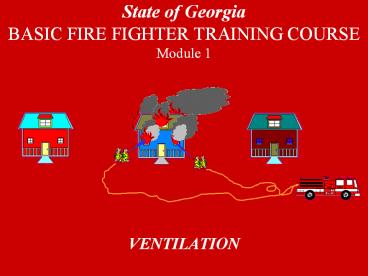VENTILATION - PowerPoint PPT Presentation
1 / 28
Title:
VENTILATION
Description:
State of Georgia BASIC FIRE FIGHTER TRAINING COURSE Module 1 VENTILATION VENTILATION The planned and systematic release and removal of heated air, smoke, and toxic ... – PowerPoint PPT presentation
Number of Views:570
Avg rating:3.0/5.0
Title: VENTILATION
1
State of GeorgiaBASIC FIRE FIGHTER TRAINING
COURSE Module 1
- VENTILATION
2
VENTILATION
- The planned and systematic release and removal
of heated air, smoke, and toxic gases from a
confined area and the replacement of these
products of combustion with a supply of cooler,
fresh air.
3
PROPER VENTILATIONAdvantages
- Simplifies rescue
- Reduces flashover hazards
- Reduces backdraft hazards
- Reduces mushrooming
- Speeds extinguishment
- Salvage operations
- Reduces damage
- Decreases danger
- Easier firefighting
- Confines the fire
4
VENTILATION EFFECTS
- IMPROPER
- Fire may Spread
- Potential Backdraft
- May delay rescue
- Potentially harmful to occupants
- PROPER
- Improved visibility
- Lower temperatures
- Safer working conditions
5
TYPES OF VENTILATIONNatural
6
TYPES OF VENTILATIONForced
7
TYPES OF FORCED VENTILATON
- Mechanical
- Depressurization
- Pressurization
8
MECHANICAL VENTILATIONDepressurization
- Advantages
- effective when others are not
- ensures positive control
- supplements other methods of ventilation
- may be faster than natural ventilation
- good public relations
- Disadvantages
- May cause fire to intensify and spread
- Needs a power source
- Special equipment is required
- Interferes with egress and ingress
9
MECHANICAL VENTILATIONPressurization
- Disadvantages
- Needs a power source
- Special equipment is required
- May cause fire to intensify and spread
- Advantages
- done without entering structure
- doesnt interfere with ingress or egress
10
HYDRAULIC VENTILATION
- Disadvantages
- increase in water damage
- increases demand on water supply
- freezing of water
- time in is limited
- firefighters may remain in structure
- Advantages
- requires no special equipment
- can be performed by the same firefighter
- removes smoke faster than mechanical ventilation
11
VENTILATIONConsiderations
- Life safety conditions
- Building conditions
- Fire conditions
12
BACKDRAFTEffects
- Structural damage
- Serious injury
- Flying debris
- Additional heat or fire damage
13
BACKDRAFTPrevention
- Control openings
- Open slowly
- Natural vertical ventilation
14
ROOF TYPES
15
ROOF TYPES
16
ROOF TYPES
17
VERTICAL VENTILATION Safety Precautions
- Wear full protective equipment
- Determine the safety of the building and roof
- IF UNSAFE STAY OFF !!!
- Have a charged hose line ready and in position
- Coordinate ventilation with other crews
- Observe wind direction in relation to exposures
18
VERTICAL VENTILATION Safety Precautions
- Note the existence of and avoid obstructions or
excessive weight on the roof - Extend ladder 3 to 5 rungs above the roof line
- Sound the roof for structural integrity before
stepping on to it - Provide two means of escape
- Use life lines, roof ladders or other means to
prevent slipping or falling
19
VERTICAL VENTILATION Safety Precautions
- Work in groups of two but no more than necessary
- Use caution around electrical wires
- Use tools with caution and beware of others
- Start power tools on the ground and shut off
before hoisting - Avoid cutting main structural supports
20
VERTICAL VENTILATION Safety Precautions
- The angle of cut should be away from the body
- Guard the opening in the roof
- Evacuate the roof when ventilation is complete
- Use support members of the structure for travel
21
HORIZONTAL VENTILATION Safety Precautions
- Wear full protective equipment
- Determine the safety of the building
- Work in groups
- Provide two means of escape
- Have a charged hose line ready and in position to
protect exposures - Coordinate ventilation with other crews
- Use caution around electrical wires
- Use tools with caution.
22
VENTILATION TOOLS
- Pike pole
- Pick-head axe
- Power Saw
- Ladders
23
NATURAL VERTICAL VENTILATIONProcedure
- Determine where to ventilate
- Ladder 5 rungs above the roofline
- Deploy roof ladder
- Locate roof supports
- Make the opening at least 4 X 4
- Remove roof materials
- Cut decking alongside joist
- Pry up boards
- Open ceiling below
24
NATURAL HORIZONTAL VENTILATION Procedure
- Determine where air is to be channeled
- Determine where to ventilate
- Open structure on windward side as low as
possible - Open structure on leeward side as high as
possible.
25
NATURAL TRENCH VENTILATION
- Follow same safety precautions as for vertical
ventilation - Determine where the opening is to be made
- Ahead of the fire
- Cut trench from one exterior wall to the other
- 4 feet wide
- Use same procedures as for vertical ventilation
26
DEPRESSURIZATION VENTILATION
27
PRESSURIZED VENTILATION
28
HYDRAULIC VENTILATION































